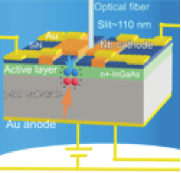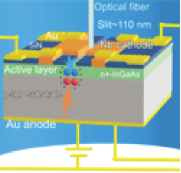Superconducting LED
The macroscopic quantum coherence of Cooper pairs in a superconductor has been exploited for a variety of applications, including the realization of qubits in quantum information processing and high-speed single-photon detection. The latter application relies on the fact that absorption of photons with energies below the superconducting gap preserves the Cooper pairs, whereas absorption of photons above the threshold destroys them.
Presenting their results in Physical Review Letters, H. Sasakura at Hokkaido University, Japan, and co-workers have demonstrated a unique application of superconductivity to enhance band-to-band radiative recombination in a semiconductor. The setup consists of epitaxially grown light emitting diode (LED) layers made up of -type on top of a -type substrate. The LED layers are then covered by an ohmic contact layer, followed by niobium ( ) electrodes. Below a certain critical temperature, a Josephson junction is established, with the LED layer sandwiched in between the superconducting electrodes. Most notably, there is a drastic enhancement of photon generation in the LED layer from the recombination of electron Cooper pairs—injected by means of the proximity effect—with holes injected by the -type electrode. This development opens up the possibility of a new interdisciplinary field: superconducting optoelectronics. – Sarma Kancharla





